mobile View, to the German Version tap the flag


- Republic of Karakalpakstan
- also: Karakalpakia
- autonomous republic within Uzbekistan
- own name: Qaraqalpaqstan Respublikasi
• Flag
• Historical Flags
• Meaning/Origin of the Flag
• Coat of Arms
• Meaning/Origin of the Coat of Arms
• Map
• Numbers and Facts
• History
• Origin of the Country's Name
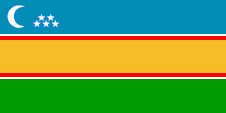
since 1990
National flag,
ratio = 1:2,
Source, by: Wikipedia (D)




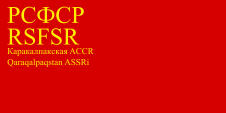
1934–1937,
Flag of the Karakalpakian ASSR,
ratio = 1:2,
Source, by:
Flags of the World



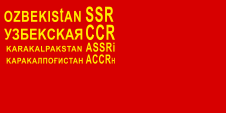
1937–1941,
Flag of the Karakalpakian ASSR,
ratio = 1:2,
Source, by:
Flags of the World



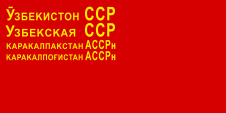
1941–1952,
Flag of the Karakalpakian ASSR,
ratio = 1:2,
Source, by:
Flags of the World



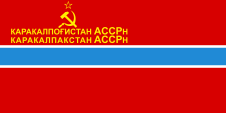
1952–1990,
Flag of the Karakalpakian ASSR,
ratio = 1:2,
Source, by:
Flags of the World



look also:
Flag history of the soviet republics of the USSR

The design of the flag of Kakakalpakstan is greatly orientatet in the flag of Uzbekistan, to which Kakakalpakstan politically belongs. The flag of Kakakalpakstan shows three horizontal sripes in blue, yellow and green, whereas the yellow middle stripe is bordered by narrow red-white stripes. In the blue upper stripe are to recognize a white half-moon and five white five-pointed stars. The half-moon and the colour green stand for the Islam, the blue stands for the water and the heaven, and the white for peace, prosperity und harmony. Green symbolizes fertility and agriculture and yellow stands for the Karakalpakian people. The colours are given in hexadecimal (RGB) with Blue #008FB8, Red #DB2017, Yellow #F7BE24, Green #1A9D37, which would correspond to CMYK Blue 79|18|10|15, Red 0|94|100|0, Yellow 0|27|93|0, Green 80|0|100|5, which would correspond to Pantone Blue 7460, Red 1795, Yellow 7408, Green 362.
Source:
Wikipedia (D),
Wikipedia (EN)

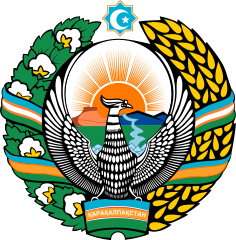
Coat of arms of Karakalpakstan,
Source, by:
File:Emblem_of_Uzbekistan.svg: VariousNikNaks talk - gallery - wikipedia,
Public domain, via Wikimedia Commons
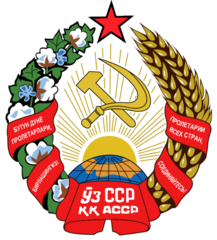
1978 (1937)–1993
Coat of arms of the Karakalpak Autonomous Soviet Socialist Republic,
Source, by:
Jamshid Nurkulov, CC BY-SA 4.0, via Wikimedia Commons

The today's coat of arms of Karakalpakstan was created by Jollybai Izentaev and was adopted on 9th of April in 1993. It is based on the coat of arms of Uzbekistan and shows the rising sun, the ancient Zoroastrian fortress of Chilpyk, the Amu Darya River and the Aral Sea. It is surrounded by a wreath of wheat ears and cotton branches. At the top is a blue octahedron with a crescent moon and star in white. The figure in the centre is the mythical Kumai bird. The banner in the colours of the flag shows the country's name in Cyrillic script: "KАРАKАЛПАKСТАН" ("QARAQALPAQSTAN").
Source:
Wikipedia (EN)

Location of Karakalpakistan (flat red) within Uzbekistan:
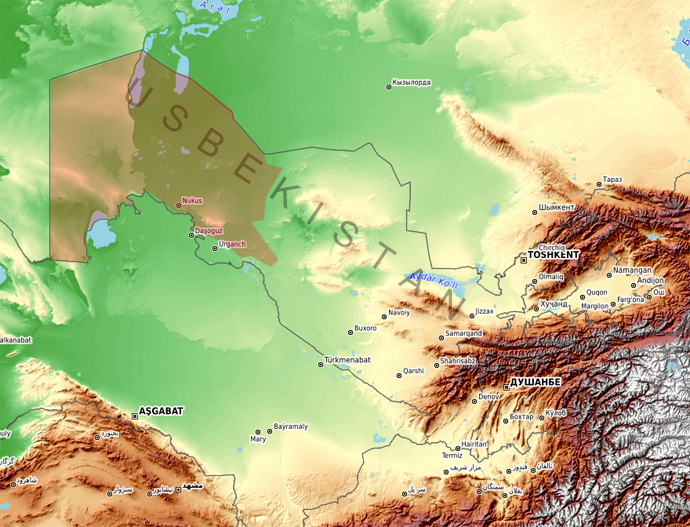
Kartendaten: ©
OpenStreetMap-Mitwirkende, SRTM | Kartendarstellung: ©
OpenTopoMap
(CC-BY-SA)

Area: 63.668 square miles
Inhabitants: 1.817.500 (2017), thereof 36% Uzbeks, 33% Karakalpaks, 25% Kazakhs
Density of Population: 29 inh./sq.mi.
Capital: Nukus, 312.000 inh. (2018)
official Languages: Uzbek, Karakalpakian
other Languages: Kazakh, Russian
Currency: Uzbek currency
Time Zone: GMT + 5 h
Source:
Wikipedia (D)

16th cent. · the Turkish people of the Karakalpaks (translated: "black caps") settles near the river Syrdaria, ca. 750 km far from its today's settlement areas
18th cent. · expulsion of the Karakalpaks by the Kazakh, escape in western direction in the region of the Khanate of Khiwa southern the Aral Sea, but also in southern direction, in the region of the Khanate of Kokand (Fergana Valley)
1824–1853 · Russian conquest of Kazakhstan
1865–1868 · Russian conquest of Uzbekistan, Kyrgyzstan and of the Khanate of Kokand, establishment of the des General Government of Turkestan
1868 · Russian conquest of the Khanate of Bukhara
1873 · Russian conquest of the Khanate of Chiwa, in this way come parts of the today's Karakalpakstan under influence of Russia
1876 · the Khanates of Bukhara and Khiwa become formally independent as Russian protectorates
1922 · establishment of the Soviet Dictatorship, the Khanate of Khiwa becomes "Khoresmian Soviet People's Republic"
1924 · summary of the Khoresmian Soviet People's Republic and the Socialistic People's Republic of Bukhara to the Uzbek Socialistic Soviet Republic (Uzbekistan), incorporation into the Soviet Union
1925 · establishment of the Karakalpakian Autonomous Province within Uzbekistan
1932 · the Karakalpakian Autonomous Province becomes Karakalpakian Autonomous Socialistic Soviet Republic, but incorporated into Soviet Russia (Russian Socialistic Federative Soviet Republic)
1936 · the Karakalpakian Autonomous Socialistic Soviet Republic gets incorporated back into the Uzbek Socialistic Soviet Republic
1991 · proclamation of the Autonomous Republic of Karakalpakstan (within Uzbekistan)
2022 · Uzbekistan considers the possibility of limiting the autonomy of Karakalpakstan by amending the constitution; demonstrations and riots break out in Karakalpakstan with several deaths; on 2nd of July in 2022 Uzbekistan announces that it will refrain from amending the constitution; the situation calms down
Source:
Wikipedia (D),
World Statesmen

The name of the country goes back to the Turk people of the Karakalpaks, who have lived here since the 18th century. The name of the people is to translate as "black hats".
Source:
Volker Preuß


![]()











